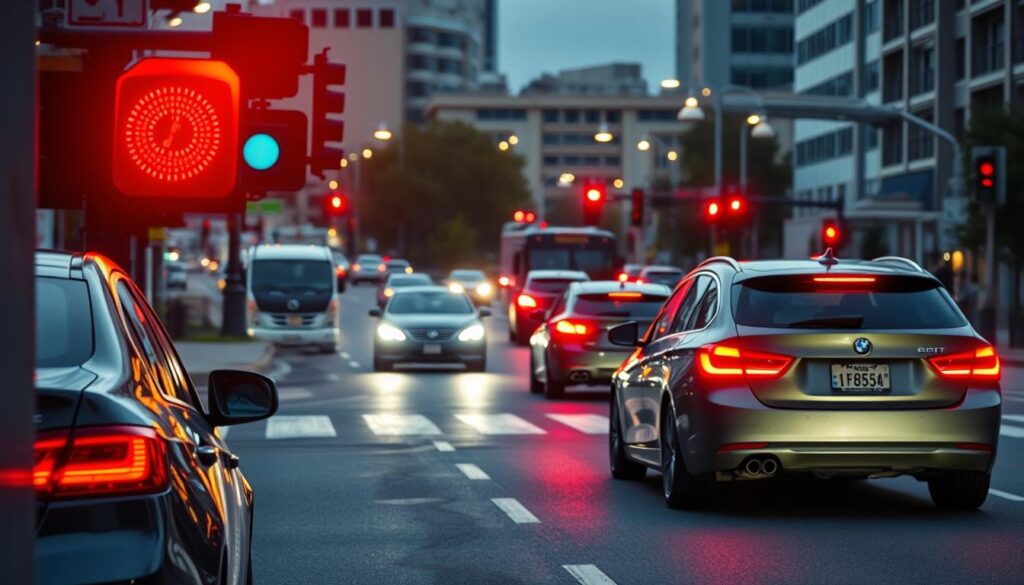Common Driving Mistakes and How to Avoid Them
Did you know that a staggering 90% of all car accidents are caused by human error? That’s a fact from traffic safety studies. Yet, a surprising 8 out of 10 people believe they are above-average operators behind the wheel. This gap between perception and reality is where danger hides on every journey.
In 2021, nearly 43,000 lives were lost in traffic incidents in the U.S. What’s truly eye-opening is that only 20% of those tragedies were alcohol-related. This reveals a hard truth: everyday errors are a leading cause of serious crashes. This guide is here to help you spot and correct these frequent oversights.
Whether you’re new to the road or have years of experience, everyone can benefit from a refresher. We’ll explore issues like speed control, distractions, and lane discipline. Our goal is to provide friendly, practical advice to boost your safety and confidence. Let’s work together to make our roads safer for everyone.
Key Takeaways
- Human error is the primary cause of the vast majority of car accidents.
- Most people overestimate their own driving skills, creating a safety gap.
- A large number of serious crashes result from routine errors, not just major violations.
- Improving safety starts with recognizing and understanding frequent oversights.
- Practical solutions exist for issues like distraction and improper speed control.
- Becoming a more aware operator protects you, your passengers, and others on the road.
The True Cost of Driving Errors on the Road

Behind the sobering statistic of 43,000 traffic fatalities in 2021 lies a story of routine errors with devastating consequences. What’s more startling is that only 20% involved alcohol. This means the vast majority stem from everyday oversights anyone can make.
Traffic Fatalities and Human Error
Human error is the culprit in about 90% of all accidents. This fact is powerful because it means most crashes are preventable. If drivers can spot their own driving mistakes, they can stop tragedy before it happens.
There’s often a gap between knowledge and action. For example, 82% of people agree that speeding is dangerous. Yet, over half admit to doing it regularly. This disconnect puts everyone on the road at risk.
Impact on Daily Commutes
These errors don’t just cause major accidents. They also ruin our daily commutes. A single driver making an improper lane change can cause a chain reaction of braking.
This leads to traffic jams, wasted time, and frustration for everyone. The financial costs are also huge. Think about higher insurance, car repairs, and medical bills from fender benders.
Even a small mistake can have a big ripple effect. Understanding this true cost is the first step toward becoming a safer, more mindful driver for all drivers.
Speed and Vehicle Control: Avoiding Risky Maneuvers
Many operators underestimate how important matching speed to current conditions truly is for road safety. This oversight affects everyone sharing the pavement.
Failure to Control Speed and Speeding Hazards
Going too fast isn’t just about breaking the posted limit. It’s about traveling at an unsafe pace for the conditions. Rain, fog, or ice demand slower movement.
Your car needs more time and distance to stop when you’re moving quickly. This physics principle can’t be ignored. Doubling your speed quadruples your stopping distance.
Even traveling at the speed limit can be dangerous in poor weather. Adjust your pace by one-third in rain and by half in snow. This simple mistake of improper speed control turns minor incidents into major problems.
When Driving Too Slowly Becomes Dangerous
Moving well below the flow of traffic creates hazards too. It forces other drivers to pass frequently.
Each lane change increases collision risk. Maintain a pace that matches the road situation around you. This keeps the vehicle flow smooth and predictable.
Proper speed management gives you the reaction time needed for safe decisions. It’s about control, not just compliance.
Staying Focused: Overcoming Driver Distraction

In our hyper-connected world, the battle for a driver’s attention is constant and fierce. This form of distracted driving is a top safety concern, directly impacting your ability to react to hazards in time.
Managing Inattention Behind the Wheel
Safe operation requires three things: hands on the wheel, eyes on the road, and your mind on the driving task. A distracted driver misses one or more of these essentials.
Texting is especially dangerous. It takes your eyes, hands, and focus away at once. Other frequent mistakes include eating, adjusting the radio, or talking with passengers.
Even in parking lots, drivers get distracted. Studies show over 60% use phones, and more than half groom themselves while behind the wheel. Emergencies happen without warning. You need your full attention to respond safely.
Techniques to Avoid Distracted Driving
Simple habits can protect you. Put your phone in the backseat or glove box before you start the car. Program your GPS and music playlist before you move the vehicle.
If you must deal with something, pull over to a safe spot. No call or text is worth the risk. Your primary job behind wheel is driving. Make focus your absolute limit.
Lane Discipline: Safe Lane Changes and Lane Keeping

The simple act of changing lanes requires more precision than most people realize, making it a frequent source of roadway incidents. Proper lane management keeps traffic flowing smoothly and prevents unnecessary collisions.
Improper Lane Changes and Blind Spot Checks
Many collisions occur when drivers change lanes without proper preparation. The MSB method—Mirror, Signal, Blind spot check—provides a reliable sequence for safety.
First, check your rearview and side mirrors for approaching vehicles. Then activate your turn signal to alert other drivers. Finally, perform a thorough blind spot check by turning your head.
| Safety Step | Proper Technique | Common Error |
|---|---|---|
| Mirror Check | Scan all mirrors systematically | Quick glance or skipping entirely |
| Signal Use | Activate 5 seconds before moving | Signaling during or after the move |
| Blind Spot Check | Head turn to verify clear path | Relying only on mirrors |
Keeping Within Your Lane
Drifting out of your lane forces other vehicles to take evasive action. Maintain consistent lane position by watching road markings and keeping hands at 9 and 3 on the steering wheel.
Check your mirrors every 5-10 seconds to stay aware of surrounding traffic. This habit helps you anticipate needs and maintain safe spacing between vehicles.
Maintaining Safe Distances and Observing Road Rules

The space you leave in front of your car is your most important safety tool, yet it’s often underestimated. This simple distance provides the precious time needed to react to sudden changes on the road.
Avoiding Tailgating and Following Too Closely
Many people follow other vehicles too closely without realizing the risk. This habit, called tailgating, leaves no room to stop if the car in front brakes suddenly.
The best way to ensure a safe following distance is the three-second rule. Here’s how it works:
- Watch the vehicle ahead pass a fixed point, like a sign.
- Start counting: “one-thousand-one, one-thousand-two, one-thousand-three.”
- If you pass the point before you finish, you are too close.
At 30 mph, you need about five car lengths. At 65 mph, you need at least 18. Always increase this distance in rain, fog, or at night.
Mastering Complete Stops at Intersections
Failing to make a full stop is a serious and illegal mistake. A rolling stop does not give you enough time to check for other drivers or pedestrians.
Your speedometer must read zero. Hold your foot on the brake. Look both ways before you turn or proceed. This complete stop is required by law for a reason—it saves lives.
Following these rules prevents rear-end collisions and keeps intersections safe for everyone.
Common Driving Mistakes Drivers Make: A Detailed Review

What if the biggest threat on the road isn’t other drivers, but our own misplaced confidence in our abilities? Studies show 8 out of 10 people believe they’re above-average operators. Yet human error causes 90% of accidents. This overconfidence gap puts everyone at risk.
Overconfidence and Inadequate Preparation
Experienced drivers often become complacent. They might skip mirror checks or take unnecessary risks. This false sense of security leads to preventable errors.
Fatigue is another serious concern. Drowsiness impairs reaction time and decision-making similar to alcohol. Driving while tired is one of the deadliest mistakes people make.
Harsh braking and acceleration cause problems too. They increase collision risk and waste fuel. Smooth operation protects both your vehicle and others on the road.
Parking lots demand special attention despite lower speeds. Pedestrians, shopping carts, and backing vehicles create complex environments. Stay focused even when you think the danger has passed.
Simple preparation prevents many issues. Adjust your seat and mirrors before starting your trip. Plan your route in advance to avoid last-minute decisions.
Remember that skills need constant refinement. Honest self-assessment helps identify areas for improvement. Every driver can benefit from reviewing their habits regularly.
Defensive Driving Strategies for Evasive Action
Imagine debris suddenly falling from a truck directly into your path—your response in that split second defines defensive driving. This proactive approach goes beyond following rules. It’s about anticipating hazards before they become emergencies.
Anticipating Hazards on the Road
Poor evasive action often happens when people panic. Keeping both hands on the wheel and your full attention ahead is crucial. This preparation gives you the time needed to react safely.
Create a “space cushion” around your vehicle. This buffer provides escape routes if hazards appear. Scan the road 12-15 seconds ahead to spot potential dangers early.
In bad weather, your strategies must adapt. Increase your following distance and reduce speed. Be extra careful on bridges where ice forms first.
Use these specific techniques for safe driving:
- Cover your brake when approaching uncertain situations.
- Position your car to avoid risks from other drivers.
- Always have an escape plan in mind.
Assume other drivers make errors. This mindset helps you stay prepared. Consider a defensive driving course to master these life-saving skills behind the wheel.
Conclusion
Road safety isn’t about perfection—it’s about consistently applying the simple techniques that prevent most collisions. The vast majority of traffic incidents stem from preventable errors that anyone can correct with awareness and commitment.
Becoming a safer operator means recognizing which behaviors need improvement and actively working on them every time you’re behind the wheel. Regardless of your experience level, everyone benefits from reviewing essential practices.
Implement the specific strategies we’ve discussed: maintain proper following distance, always check blind spots before changing lanes, and keep both hands on the steering wheel. Small changes like putting away your phone and coming to complete stops dramatically reduce risk.
Breaking old habits takes conscious effort, but the investment in safety is invaluable. Consider a defensive driving course to further enhance your skills. Starting today, you can contribute to safer roads for everyone.
FAQ
What is the most frequent error people make behind the wheel?
How can I maintain a safe speed in different weather conditions?
Why is tailgating such a dangerous habit?
What’s the best way to avoid distracted driving?
Is driving too slowly actually a problem?

Eduard Kingly is a travel and lifestyle content creator with a focus on personal development and education. He combines firsthand travel experiences with research-driven insights to guide readers in discovering new places, building better habits, and pursuing meaningful learning.




